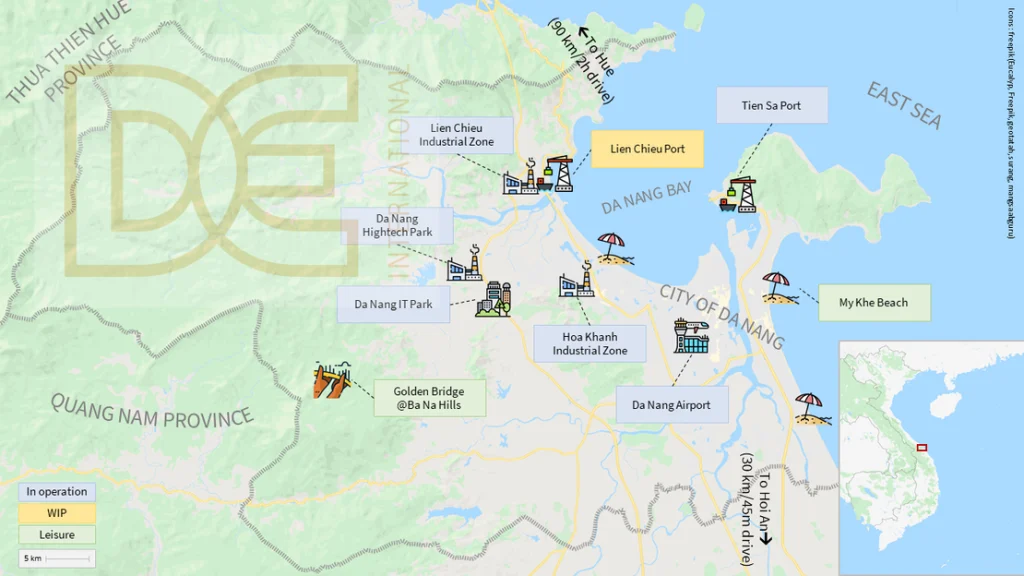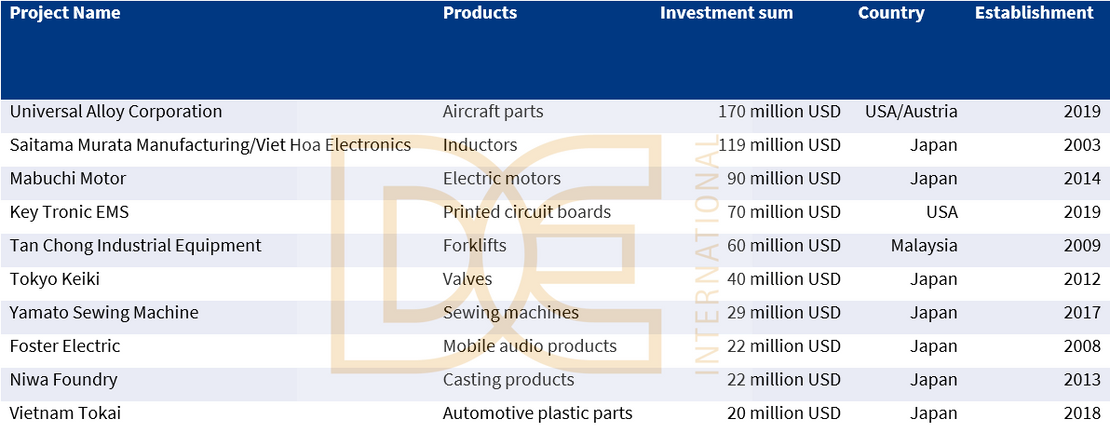
Investment in Da Nang: A Rising Star for Tourism and High-Tech Industries
At first, known for its year-round warm climate, over 20 kilometers of pristine white sandy beaches, and stunning mountain landscapes, Da Nang is a premier destination for travelers. Home to three nearby UNESCO World Heritage sites, Vietnam’s fourth-largest city has consistently ranked as the country’s most popular tourist hotspot. But beyond its appeal to vacationers, investment in Da Nang is gaining momentum across various sectors. The city has developed into a thriving hub for software development and is making significant strides in high-value manufacturing. Major infrastructure projects and top-tier foreign investments are driving this transformation, positioning Da Nang as a strategic location not only for tourism but also for tech innovation and industrial growth. For investors seeking opportunities in Vietnam, investment in Da Nang offers both potential and promise.
Please note that this article is part of a marketing project in cooperation with Danang Hi-tech Park and Industrial Zones Authority.
Strategic Location Driving Investment in Da Nang
Ideally positioned on the East Sea with direct access to the Pacific Ocean, Da Nang holds a crucial advantage for regional trade and economic development. Surrounded by the Annamese Cordillera to the north and west, and bordered by Thua Thien Hue Province in the north and Quang Nam Province in the south, the city also oversees the Hoang Sa island chain. Furthermore, with a population of approximately 1.2 million, Da Nang ranks as Vietnam’s fourth-largest city after Ho Chi Minh City, Hanoi, and Haiphong. Thanks to this strategic location, well-connected infrastructure, and demographic strength, investment in Da Nang is becoming increasingly attractive—particularly in logistics, smart manufacturing, and high-tech industries.
From Historic Port to Economic Powerhouse
The City Rises Through History
Da Nang has long played a pivotal role in Vietnam’s development. In the 17th century, after China imposed an embargo on Japanese goods, Da Nang’s port quickly rose as a key transshipment hub between Japan and China. Though initially overshadowed by the nearby port of Hoi An, Da Nang gradually gained prominence and, by the 19th century, surpassed its neighbor in regional influence. In 1847, French colonial forces landed in Da Nang, and by 1887, the city became part of French Indochina. Later, during the Vietnam War, it served as the first landing point for American troops, which led to extensive upgrades to its airport and seaport.
Da Nang – Central Vietnam’s Economic Engine
In 1997, the Vietnamese government designated Da Nang and three neighboring provinces as the country’s third Key Economic Zone. Since then, Da Nang has evolved into the economic powerhouse of Central Vietnam. Today, the city combines its rich historical legacy with modern infrastructure and proactive development policies. This unique blend continues to attract strong investment across a wide range of industries, positioning Da Nang as one of Vietnam’s most promising growth centers.

Tourism Boom Strengthens Investment in Da Nang
Fristly, in 2019 alone, the city welcomed approximately 8.7 million visitors. Until recent global disruptions, tourist arrivals had been increasing at double-digit rates annually. Notably, Da Nang is the number one most popular destination among tourists in Vietnam. Thanks to its breathtaking natural beauty and vibrant attractions—such as the famous My Khe Beach, the Marble Mountains, the Dragon Bridge, the Golden Bridge, Ba Na Hills, and theme parks like Sun World—the city continues to captivate both domestic and international travelers. Additionally, the presence of nearby UNESCO World Heritage Sites, including Hoi An, My Son, and Hue, further enhances Da Nang’s appeal. As a result, nearly 30% of the city’s GDP is generated by the tourism sector, making it a powerful engine for investment in Da Nang.
Infrastructure and Quality of Life Fuel Long-Term Investment
In response to the city’s tourism boom, Da Nang has seen the rapid development of luxury hotels, beachfront resorts, stylish restaurants, lively bars, and trendy cafés. Moreover, international-standard hospitals and schools have been established, contributing to the city’s growing reputation as a global destination for both tourists and residents. In terms of infrastructure, Da Nang offers a modern and well-planned road network that not only surpasses Hanoi and Ho Chi Minh City in quality and coverage but also experiences far less congestion. Additionally, the cleaner air quality adds to the city’s overall charm. Consequently, Da Nang has earned a reputation among expatriates as Vietnam’s most “livable” city. This high standard of living, combined with strong infrastructure and consistent tourist demand, continues to attract foreign and domestic investment, especially in sectors such as hospitality, real estate, healthcare, and education.

Airport Development Boosting Investment in Da Nang
Da Nang International Airport is the city’s main gateway, originally built in 1940 and significantly upgraded during the 1950s and 1960s. In recent decades, the airport has expanded rapidly to meet rising demand. Terminal 1 (domestic) opened in 2011, followed by Terminal 2 (international) in 2017.
Currently serving 35 international and 10 domestic routes, the airport handled 13 million passengers in 2018, making it Vietnam’s third busiest. By 2030, that number is likely to reach 28 million, with cargo capacity doubling to 200,000 tonnes. Its central location and modern facilities make it a key driver for investment in Da Nang, especially in tourism, logistics, and trade.
Software Industry Accelerates Investment in Da Nang
Da Nang is fast becoming a tech hub, thanks to its young talent pool, affordable costs, and high quality of life. Major companies like FPT and Viettel, along with growing SMEs such as Rikkeisoft and Axon Active, are fueling the city’s tech growth.
In 2019, IT service exports reached $89 million, up 14% from 2018. The workforce in software development is expected to grow from 12,000 to 35,600 by 2025. With one Software Park in operation and three more under development, the tech sector is set to contribute 15% of Da Nang’s GDP by 2030. These developments make the digital economy a major focus for investment in Da Nang.

Manufacturing Industry
With tourism and software development accounting for nearly 40% of Da Nang’s industry, it can be said that the city is an emerging service hub. However, it is also making forays into manufacturing. 1.6 million US-Dollars have flown into industrial investments in Da Nang. Most of these manufacturing activities are originating from Japan, the USA and Korea. According to the international industry investments table, they focus on electronic components as well as high value-added products. This sets Da Nang apart from other regions in Vietnam which are more focused on low-value-add goods. The city was able to attract these investments because of the following factors:
– Young and well-educated urban workforce
– Local infrastructure:
- Airport (see above)
- Port (see below)
- Road (located on National Road 1A and the new North-South Expressway)
- Rail (located on the North-South Railway with a dedicated freight station at Lien Chieu)
– Good living environment for expats

The Benefits of Investment in Da Nang
A prominent project realized in 2019 is an aircraft part production facility of the Universal Alloy Corporation (UAC). With an investment sum of 170 million USD, this American-Austrian investment currently is the largest foreign project in Da Nang. It aims to utilize Da Nang’s ample supply of highly qualified staff. Furthermore, UAC is profiting of Da Nang Hightech Park’s favorable location as well as the investment incentives investors can receive here.
With Hoa Khanh, Lien Chieu and Da Nang Hi-tech Park (DNHTP) the city currently has three major industrial zones. Our partner for this article, DNHTP, is the youngest of these projects and thus offers the most available space.
Da Nang Hi-tech Park has been established in 2010 and currently operates 179 ha of land. It is only the third “Hightech Park” after similar projects in Hanoi and Ho Chi Minh City. It offers very competitive pricing for land. Also, investors in DNHTP enjoy CIT exemptions and reductions for up to 28 years after their first year of taxable income. To make use of these incentives, companies have to focus on activities stipulated in a list of investment in “hi-tech” parks in Vietnam. Furthermore, 1% of annual revenue will be invested in R&D. Another advantage of DNHTP is its proximity to the new Da Nang port.
Port Development
Tien Sa – The Historical Heart of Da Nang Port
Da Nang is the central outport for the whole central region. It has held this role since the 19th century, when the French administration established the current main terminal, Tien Sa. During the 1960s, the Americans expanded the port to support their war efforts in Vietnam. Tien Sa terminal offers a natural harbor with sufficient draft and calm waters on the eastern edge of Da Nang Bay. It can accommodate ships of up to 70,000 DWT and currently handles about 12 million tons of cargo annually. However, while freight volumes are growing by double digits, the space at Tien Sa is no longer sufficient to meet demand.
Lien Chieu – The Future Gateway of Central Vietnam
To address the capacity limitations of Tien Sa, city leaders have approved the development of a new terminal: Lien Chieu, located on the west side of Da Nang Bay. The first phase of this project, with an investment of US$315 million, is expected to handle 3.5 million passengers annually and be completed by 2022. Once all three phases are completed, possibly by 2030, Lien Chieu Port will be able to handle about 20 million tons of cargo per year. At that time, Tien Sa will transition into a tourist port dedicated to receiving cruise ships.
Conclusion
In summary, Da Nang has a strong standing in Vietnam’s recent history. However, after the country’s reunification in 1975 the city struggled to live up to its potential. Capitalizing on its natural environment, it eventually developed tourism as a first pillar of its local economy. Its young and qualified workforce then attracted software development companies. IT services today is Da Nang’s second economic pillar. In the future, the city will probably shape itself into a magnet for high-tech manufacturing investments. Da Nang’s favorable natural environment, its excellent logistical connection, the highly qualified workforce as well as its effective administrative support are key factors for this development. And thus, we will likely see more “High-Tech on the Beach”.
…and Action! Here is our video on Da Nang:



